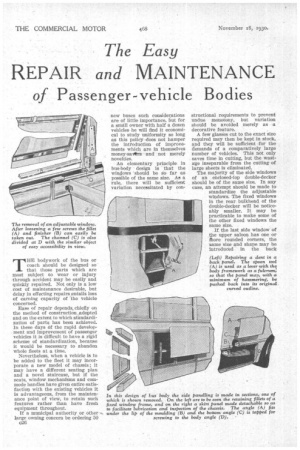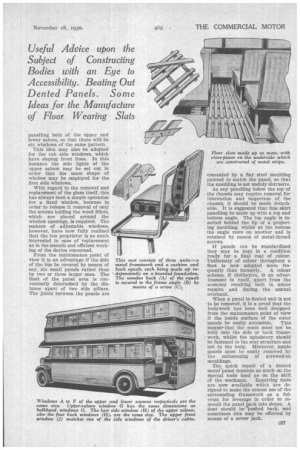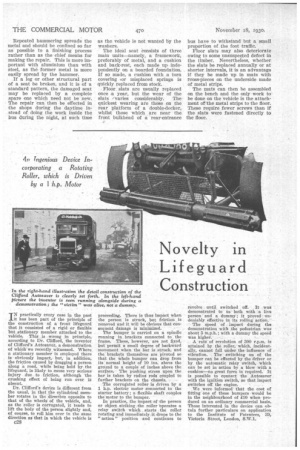The Easy REPAIR and MAINTENANCE of Passenger-vehicle Bodies
Page 48

Page 49

Page 50

If you've noticed an error in this article please click here to report it so we can fix it.
Useful Advice upon the Subject of Constructing Bodies with an Eye to Accessibility. Beating Out Dented Panels. Some Ideas for the Manufacture of Floor Wearing Slats
THE bodywork of the bus or coach should be designed so that those parts which are most subject to wear or injury through accident may be easily and quickly repaired. Not only is a low cost of maintenance desirable, but delay in effecting repairs entails loss of earning capacity of the vehicle concerned.
Ease of repair depends, chiefly on the method of construction adopted and on the extent to which standardization of parts has been achieved. In these days of the rapid development and improvement of passenger vehicles it is difficult to have a rigid scheme of standardization, because it would be necessary to abandon whole fleets at a time.
Nevertheless, when a vehicle is to be added to the fleet it may incorporate a new model of chassis; it may have a different seating plan and a novel staircase, but if the seats, window mechanisms and commode handles have given entire satisfaction with the existing vehicles it is advantageous, from the maintenance point of view, to retain such features rather than have fresh equipment throughout.
If a municipal authority or other large owning concern be ordering 50 026 new buses such considerations are of little importance, but for a small owner with half a dozen vehicles he will find it economical to study uniformity so long as this policy does not hamper the introduction of improvements which are in themselves money-savlbrs and not merely novelties.
An elementary principle in bus-body design is that the windows should be so far as possible of the same size. At a rule, there will be sufficient variation necessitated by con
structional requirements to prevent undue monotony, but variation should be avoided merely as a decorative feature.
A few glasses cut to the exact size required may then be kept in stock, and they will be sufficient for the demands of a comparatively large number of vehicles. This not only saves time in cutting, but the wastage inseparable from the cutting of large sheets is eliminated.
The majority of the side windows of an enclosed-top double-decker should be of the same size. In any case, an attempt should be made to standardize the adjustable windows. The fixed windows in the rear bulkhead of the double-decker will be noticeably smaller. It may be practicable to make some of the other fixed windows the same size. .
If the last side window of the upper saloon has one or ftiore rounded corners, the same size and shape may be Introduced in the back
panelling both of the upper and lower saloon, so that there will be six windows of the same pattern.
This idea may also be adopted for the cab side windows, which have sloping front lines. In this instance the side lights of the upper saloon may be set out in order that the same shape of window may be employed for the first side windows.
With regard to the removal and replacement of the glass itself, this has always been a simple operation for a fixed window, because in order to release it removal of only the screws holding the wood fillets, which are placed around the window openings, is required. The makers of adjustable windows, however, have now fully realized that the bus proprietor is as much interested in ease of replacement as in the smooth and efficient working of the device concerned.
From the maintenance point of view it is an advantage if the side of the bus be covered by means of say, six small panels rather than by two or three larger ones. The limit of the panel area is conveniently determined by the distance apart of two side pillars. The joints between the panels are concealed by a flat steel moulding painted to match the panel, so that the moulding is not unduly obtrusive.
As any panelling below the top of the chassis may require removal for lubrication and inspection of the chassis, it should be made detachable. It is suggested that this skirt panelling be made up with a top and bottom angle. The top angle is inserted behind the lip of a projecting moulding, whilst at the bottom the angle rests on another and is retained by means of metal-thread screws.
If panels can be standardized they may be kept in a condition ready for a final coat of colour. Uniformity of colour throughout a fleet is now adopted more fre quently than formerly. A colour scheme, if distinctive, is an advertisement in itself, apart from the economy resulting both in minor repairs and during the annual overhaul.
When a panel Is dented and is not to be removed, it is a proof that the bodywork has been well designed from the maintenance point of view if the inside surface of the outer panels be easily accessible. This means* that the seats must not be built into the side or back framework, whilst the upholstery should be fastened to the seat structure and not to the body. Moreover, inside panels must be easily removed by the unfastening of screwed-on mouldings.
The quick repair of a dented metarpanel depends as much on the special tools used as on the skill of the workman. Repairing tools are now available which are designed to make the utmost use of the surrounding framework as a fulcrum for leverage in order to remould the panel back into shape. A dent should be -bushed back, and sometimes this may be effected by means of a screw jack.
Repeated hammering spreads the metal and should be confined so far as possible to a finishing process rather than as the chief means for making the repair. This is more important with aluminium than with steel, as the former metal is more easily spread by the hammer.
If a leg or other structural part of a seat be broken, and it is of a standard pattern, the damaged seat may be replaced by a complete spare one which need not be new.
The repair can then be effected in•the shops during the daytime in
stead of doing the work inside the bus during the night, at such time as the vehicle is not wanted by the washers.
The ideal seat Consists of three main units—namely, a framework, preferably of metal, and a cushion and back-rest, each made up independently on a boarded foundation. If so made, a cushion with .a torn covering or misplaced springs is quickly replaced from stock.
Floor slats are usually replaced once -a year, but the wear of the slats /varies considerably. The quickest wearing are those on the rear platform of a double-decker, whilst those which are near the front bulkhead of a rear-entrance
bus have to withstand but a small proportion of the foot traffic.
Floor slats may also deteriorate -owing to some unsuspected defect in the timber. Nevertheless, whether the slats be replaced annually or at shorter, intervals, it is an advantage if they be made up in mats with Mss-pieces on the underside made of metal strips.
The mats can then be assembled on the bench and the only work to be done on the vehicle is the attachment of the metal strips to the floor. These require fewer screws than if the slats were fastened directly to the floor.












































































































